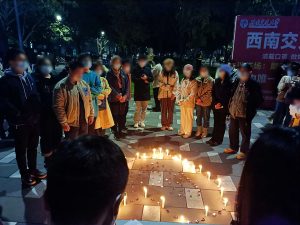When COVID-19 rocked the world in 2020, the “China Dream” became a global nightmare. China is once again enveloped in its own COVID-19 nightmare as local medical supplies are running low or out. Official data on the current wave of COVID-related deaths is questionable, but international experts project an impending 1 million COVID-related deaths in China in 2023.
Despite the Chinese Communist Party’s recent steps to loosen COVID-19 quarantine restrictions in Beijing, Shanghai, Shenzhen, and other major commercial megacities, its current approach to the pandemic ultimately has the same motivation as its “zero COVID” policy. The CCP’s default relax-and-restrict crisis management techniques only serve to fortify party control – in spite of disastrous consequences.
China’s current COVID-19 surge is a repercussion of Beijing’s easing of the zero-COVID policy in response to public protests. That discontent represented a rude awakening from the China Dream extolled by Chinese leaders.
In late November, candlelight vigils and blank paper demonstrations across major cities and universities in China reflected deep despair and raw rage among China’s youth and workers. The throes of discontent had unleashed another dream: Contrary to the official China Dream, China’s middle class yearns for freedom and truth. Despite being systematically and randomly locked up and silenced in their homes and factories, these dreamers dared to stand up and speak with their own voice.
The protests raised fundamental questions: Has the China Dream turned into a “Chinese nightmare”? Is the “great rejuvenation of the Chinese nation” pursued by the CCP actually the regression of the Chinese people?
The CCP has its dream of total control; the Chinese people have their dream of individual freedom. The zero-COVID protests and the pandemic’s unfolding resurgence have magnified the collision of both dreams.
The China Dream has been Xi Jinping’s ideological cornerstone since 2013 when he became China’s top leader. An elemental notion ironically introduced by an American columnist in 2012, this China Dream offered an alternative to the “American Dream,” which empowers the pursuit of individual freedom, identity, expression, value, and prosperity. Beijing understood that such ideals posed a potential threat to the Chinese Communist modus operandi. To maintain credibility and legitimacy, the CCP needed a palatable national narrative with global resonance.
The China Dream sought to subsume individual dreams into an ubiquitous national dream with ideational elements, including “pursuing strength of the country, rejuvenation of the nation and happiness of the people.” Steeped in the ethos of China’s civilizational centrality, the China Dream would imbue the country’s national identity and image with universality. According to Xi, “The Chinese Dream, a dream about peace, development, cooperation and win-win, is closely linked with the beautiful dreams of people in countries around the world.”
In the new era under Xi, the China Dream has served as the touchstone for China’s state-society relations and foreign affairs. As long as the CCP could deliver economic prosperity and preserve stability, the Chinese people and global markets, the party presumed, would acquiesce to the central government’s increasingly aggressive policies and practices. The repression of Muslim Uyghurs in Xinjiang; wolf warrior diplomacy abroad; the heavy-handed crackdown in Hong Kong; reining in China’s tech titans, including Alibaba’s Jack Ma; clamping down on the private education tutoring industry; forced technology transfers, economic coercion, industrial espionage, and the surveillance-state system – all these policies reflect the reality of the China Dream.
The CCP conceived and codified the China Dream at the 19th Party Congress in 2017, at the conclusion of Xi’s first term. At this congress the CCP set strategic milestones for China’s rejuvenation – eliminate poverty by 2021; become a modernized country by 2030; a modernized military and global innovation leader by 2035; a developed economy by 2049; and a modernized great power and world-class military by 2050. The 20th Party Congress in October 2022 enshrined Xi Jinping’s Mao-esque cult-of-personality leadership with a third term to consolidate full control over national security and accelerate China’s self-reliance for economic security.
This dream has a global scope, as evidence by China’s ambitions. And for other countries, the magnitude of the China market provided the commercial magnetism of the China Dream. Xi spoke about the China Dream at a special welcome dinner hosted by the city of Seattle on September 22, 2015. Sitting in the audience during Xi’s speech, I observed the spirit of goodwill and optimism between U.S. and Chinese industry leaders that evening. Bilateral business was booming; the mutual market attraction and allure were irresistible.
At the time U.S. businesses were enrapt with the Chinese Dream. U.S. exports to China in 2015 totaled $113 billion, with 90 percent of U.S. companies confirming their growth prospects in China were the same or better than in other emerging markets – even though 80 percent of the same companies admitted that China’s policy environment is the same or worse than other markets, according to the 2015 U.S.-China Business Council Member Survey Report.
That optimism has nearly disappeared. According to the 2022 USCBC Member Survey Report, 73 percent of respondents cited China’s “COVID control measures that further complicate the geopolitical risks of doing business in China” as the top impact on their business and investment plans. Moreover, “at a record high, 87 percent of U.S. companies report enduring impacts on business from U.S.-China tensions.” Some companies are now beginning to wake up from the Chinese Dream; others are still sleepwalking.
COVID-19 originated in Wuhan, the commercial center of and most populous city in central China. Zero-COVID protests at Wuhan University, part of the demonstrations held across the country, thus had a special resonance. The anger on display symbolized the deep divergence of the China Dream and the dreams of the Chinese people, with deep repercussions for China’s future. In returning full circle to the heart of China, COVID-19 is shaking China and the rest of the world awake.
































